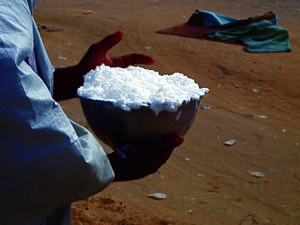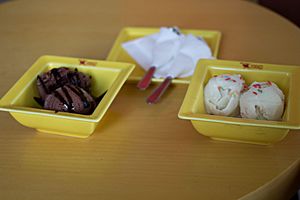Camel milk facts for kids
Camel milk has been a very important food for nomads and pastoral cultures for thousands of years. These are people who move around with their animals, like camels. In deserts and dry areas, especially in the Middle East and North Africa, camel herders can live just on milk for a long time. This happens when they take their camels on long trips to find food. Today, camel milk farming is also growing in places like Australia and the United States. It's seen as a good choice because camels are well-suited to dry lands, making it an environmentally friendly way to produce milk.
Camel milk has different nutrients compared to cow milk. But the amount of these nutrients can change a lot. This depends on things like the camel's type and age, the weather, what the camel eats, and how the milk is collected. You can use camel milk to make things like yogurt and ice cream. However, it's not as easy to turn it into butter or cheese.
Contents
History of Camel Milk Use
For a very long time, desert nomad tribes have used camel milk as a main food. They can easily make it into yogurt. Some people can even live for up to a month by drinking only camel milk. This shows how important it has been for survival in harsh environments.
How Camel Milk is Produced
| Camel milk production (whole, fresh) – 2017 |
|
|---|---|
| Country | tonnes |
| 953,673 | |
| 876,224 | |
| 300,000 | |
| 171,706 | |
| 134,266 | |
| 107,745 | |
| World | 2,852,213 |
| Source: FAOSTAT of the United Nations | |
In 2017, the world produced about 2.85 million tonnes of fresh camel milk. Most of this came from Somalia and Kenya, which together made 64% of the total. Other big producers included Mali and Ethiopia.
Camel Milk in Australia
Camels were first brought to Australia in the 1840s. They helped with exploring and trading in the tough inner parts of the country. Later, modern transport took over. Now, there are over 1.2 million wild camels in Australia, which is the largest population in the world.
Australia's first camel dairies opened in 2014. Since then, more have started, and people want more camel milk both in Australia and other countries. The government expected a big increase in camel milk production by 2021. Production grew from 50,000 litres in 2016 to 180,000 litres per year in 2019. One farm started with three wild camels in 2014 and now has over 300. This farm sends milk to Singapore and plans to send fresh and powdered milk to Thailand and Malaysia.
In 2019, one litre of pasteurised camel milk cost about AUD$15 in Australia. This was about 12 times more expensive than cow's milk. As of April 2020, Australia had seven camel dairies. These dairies make milk, cheese, and even skincare products. In 2019, one of these dairies was certified as organic.
Camel Milk in the United States
As of 2014, there were about 5,000 camels in the United States that had been brought from other countries. Making camel milk is much more expensive than making cow's milk. Female camels are rare in the US. They grow slowly and can only have babies safely after they are four years old.
A female camel must have a live baby and then feed it, or she will stop making milk. A dairy cow is separated from her calf and gives milk for 6 to 9 months. But a camel can share her milk with both the farmer and her calf for 12 to 18 months.
Milk Yields and Nutrition

Many things can affect how much milk a camel produces and what nutrients are in it. These include the amount and quality of food the camel eats, how often it drinks water, the climate, its age, how often it's milked, if its calf is nursing, and its health.
How Much Milk Camels Produce
Camels from Pakistan and Afghanistan are thought to produce the most milk, up to 30 litres per day. The Bactrian camel (which has two humps) produces about 5 litres per day. The dromedary camel (which has one hump) produces about 20 litres per day on average.
Cows that are specially bred can produce 40 litres per day in perfect conditions. However, camels can go 21 days without drinking water. They can also produce milk even when they eat poor quality food. This makes them a good choice for providing food in tough environments.
Nutritional Value of Camel Milk
The United States Food and Drug Administration (FDA) says camel milk has about 3% fat. However, the amount of fat can change a lot. It depends on the country, region, what the camel eats, how much water it drinks, and the type of camel. A report from the Food and Agriculture Organization of the United Nations in 1982 showed fat content from 1.1% (in dry areas of Israel) to 5.5% (in Ethiopia). A 2015 study found the fat content of dromedary milk to be between 1.2% and 6.4%.
Camel farmers can control some of the things that affect the milk's nutrition. Camel milk producers in Australia say their products have less fat and less lactose (a type of sugar) than cow's milk.
Products Made from Camel Milk
Camel milk can easily be made into yogurt. But it's harder to make into butter. To make butter, the milk must first be soured, then churned, and then a special agent needs to be added to make it clear.
Making Cheese from camel milk is more difficult than making cheese from cow's milk. In communities that herd camels, they make camel milk cheeses by letting the milk naturally ferment. This creates a sour curd (the solid part of milk). For example, in Sudan, the Rashaida tribe uses this method to store extra milk during the rainy season. They crush the dried curds and add water to eat them in the dry season. In Mongolia, people eat camel milk at different stages of the curd-making process.
However, camel milk does not easily turn solid (coagulate). Also, rennet from cows, which is used to make cheese, doesn't work well with camel milk. To find better ways to use the milk, the FAO asked Professor J.P. Ramet for help in the 1990s. He found a way to make the milk curdle by adding calcium phosphate and a plant-based rennet. The cheese made this way has low cholesterol and is easy to digest, even for people who can't digest lactose.
A European-style cheese called Caravane was created through teamwork. It involved a Mauritanian camel milk dairy called Tiviski, the FAO, and Professor Ramet. This cheese is said to be the only camel milk cheese in the world.
Camel milk can also be made into ice cream. In Central Asia, there is a drink called chal or shubat. It is made from fermented camel milk.
See also
 In Spanish: Leche de camella para niños
In Spanish: Leche de camella para niños


